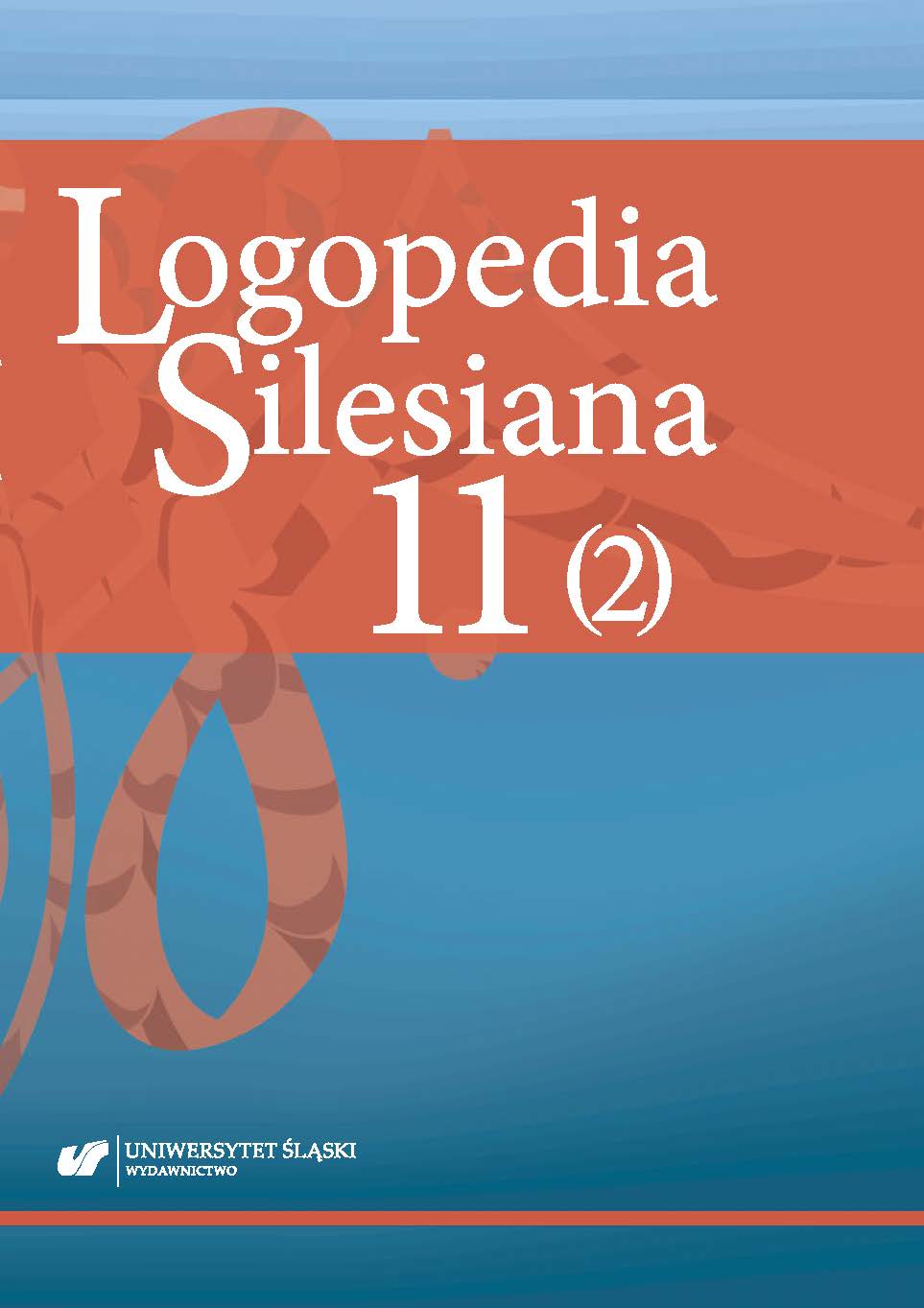Brimacombe, M., Fry-Johnson, Y., Bertrand, J., Fuller, T., Levine, R., Venable, C. L. (2009). Basic biomedical foudation. W: Fetal alcohol spectrum disorders. Competency – based curriculum development guide for medical and allied health education and practice (s. 2–7). Departament of Health and Human Services USA.
Google Scholar
Coles, C. (1998). Krytyczne okresy narażenia płodu na działanie alkoholu. Wyniki badań na modelach zwierzęcych i na ludziach. W: M. Ślósarska (red.), Uszkodzenia płodu wywołane alkoholem (tłum. A. Basaj; s. 35–50). Państwowa Agencja Rozwiązywania Problemów Alkoholowych.
Google Scholar
Eggins, S., Martin, J. R. (2001). Gatunki i rejestry dyskursu. W: T. van Dijk (red.), Dyskurs jako struktura i proces (tłum. G. Grochowski; s. 153–181). Wydawnictwo Naukowe PWN.
Google Scholar
Grabias, S. (2001). Podstawy opisu zaburzeń mowy. W: S. Grabias (red.), Zaburzenia mowy (s. 11–43). Wydawnictwo Uniwersytetu Marii Curie-Skłodowskiej.
Google Scholar
Grabias, S. (2014). Teoria zaburzeń mowy. Perspektywy badań, typologie zaburzeń, procedury postępowania logopedycznego. W: S. Grabias, Z. M. Kurkowski (red.), Logopedia. Teoria zaburzeń mowy. Podręcznik akademicki (s. 15–71). Wydawnictwo Uniwersytetu Marii Curie-Skłodowskiej.
Google Scholar
Grabias, S. (2019). Język w zachowaniach społecznych. Podstawy socjolingwistyki i logopedii. Wydawnictwo Uniwersytetu Marii Curie-Skłodowskiej.
Google Scholar
Grabias, S. (2021). Wypowiedź jako narzędzie w diagnozie i terapii logopedycznej. Dialog, opowiadanie, opis. W: A. Maciejewska (red.), Narracja w diagnozie i terapii logopedycznej (s. 13–29). Wydawnictwo Naukowe Uniwersytetu Przyrodniczo-Humanistycznego.
Google Scholar
Gray, D. D. (2010). Adopcja i przywiązanie. Praktyczny poradnik dla rodziców. Gdańskie Wydawnictwo Psychologiczne.
Google Scholar
Horecka-Lewitowicz, A., Lewitowicz, P., Adamczyk-Gruszka, O., Skawiński, D., Szpringer, M. (2013). Objawy, przebieg i postępowanie w alkoholowym zespole płodowym. Studia Medyczne, 29(2), 195–198. https://doi.org/10.5114/ms.2013.36893
Google Scholar
Jadczak-Szumiło, T. (2008). Dlaczego jest potrzebna wczesna diagnoza dla dzieci z FAS? Świat Problemów, 12, 8–11.
Google Scholar
Jadczak-Szumiło, T. (2009). Neuropsychologiczny profil dziecka z FASD. Studium przypadku. Parpamedia.
Google Scholar
Klecka, M. (2004). Alkoholowy zespół płodowy FAS. Zaburzenia pierwotne i wtórne. Bliżej Przedszkola, 4(31), 26–27.
Google Scholar
Klecka, M. (2007). FAScynujące dzieci. Wydawnictwo św. Stanisława BM.
Google Scholar
Klecka, M. (2009). Ciąża a alkohol. W trosce o dziecko. FAS. Parpamedia.
Google Scholar
Komorowska, M. (2007). Diagnoza FAS w praktyce. Remedium, 11, 6–7.
Google Scholar
Krakowiak, M. (2021). Opóźnienie rozwoju mowy u dzieci z płodowym zespołem alkoholowym. Wydawnictwo Naukowe Instytutu Kultury Regionalnej i Badań Literackich.
Google Scholar
Liszcz, K. (2011). Dziecko z FAS w domu i w szkole. Rubikon.
Google Scholar
Masgutova, S. (2008). Neurosensomotoryczna integracja odruchów u dzieci niepełnosprawnych jako skuteczna pomoc w ich codziennym funkcjonowaniu. Diagnozowanie i korekcyjna praca z dziećmi z MPD, autyzmem i FAS. Międzynarodowy Instytut Neurokinezjologii Rozwoju Ruchowego i Integracji Odruchów.
Google Scholar
Niccols, A. (2007). Fetal alcohol syndrome and the developing socio-emotional brain. Brain and Cognition, 65(1), 135–142.
Google Scholar
Okulicz-Kozaryn, K., Borkowska, M. (2015). Diagnoza FASD dla celów edukacyjnych i wychowawczych. Przegląd Pedagogiczny, 1, 168–183.
Google Scholar
Palicka, I., Śmigiel, R. (2017). Walidacja narzędzia diagnostycznego „Skale Inteligencji i Rozwoju dla Dzieci w Wieku Przedszkolnym (IDS-P)” z udziałem grupy dzieci z rozpoznanym płodowym zespołem alkoholowym wg kryteriów waszyngtońskich. Pediatria Polska, 92(5), 525–537. https://doi.org/10.1016/j.pepo.2017.05.001
Google Scholar
Pawłowska-Jaroń, H. (2011). Sfery zaburzonego rozwoju u dzieci z FASD. W: M. Michalik (red.), Biologiczne uwarunkowania rozwoju mowy (t. 2, s. 123–139). Collegium Columbinum.
Google Scholar
Polański, K., (red.). (1999). Encyklopedia językoznawstwa ogólnego. Ossolineum.
Google Scholar
Rozpoznawanie spektrum płodowych zaburzeń alkoholowych. Zalecenia opracowane przez interdyscyplinarny zespół polskich ekspertów (2020). Pediatria, 1 (wydanie specjalne), 1–44.
Google Scholar
Sierotwiński, S. (1986). Słownik terminów literackich. Teoria i nauki pomocnicze literatury. Ossolineum.
Google Scholar
Sławiński, J. (red.). (1988). Słownik terminów literackich. Ossolineum.
Google Scholar
Trzaskalik, J., Pyttel, J. (2017). Dziecko z FAS (płodowy zespół alkoholowy) w edukacji. Nauczyciel i Szkoła, 1(61), 11–25.
Google Scholar
Weinberg, J., Sliwowska, J. H., Lan, N., Hellemans, K. G. C. (2008). Prenatal alcohol exposure: Foetal programming, the hypothalamic – pituitary – adrenal axis and sex differences in outcome. Journal of Neuroendocrinology, 20(4), 470–488. https://doi.org/10.1111/j.1365-2826.2008.01669.x
Google Scholar
Zimbardo, P. G., Gerrig, R. J. (2012). Psychologia i życie. Przeł. E. Czerniawska [i in.]. Wydawnictwo Naukowe PWN.
Google Scholar


 https://doi.org/10.31261/LOGOPEDIASILESIANA.2022.11.02.05
https://doi.org/10.31261/LOGOPEDIASILESIANA.2022.11.02.05

 10.31261/LOGOPEDIASILESIANA
10.31261/LOGOPEDIASILESIANA